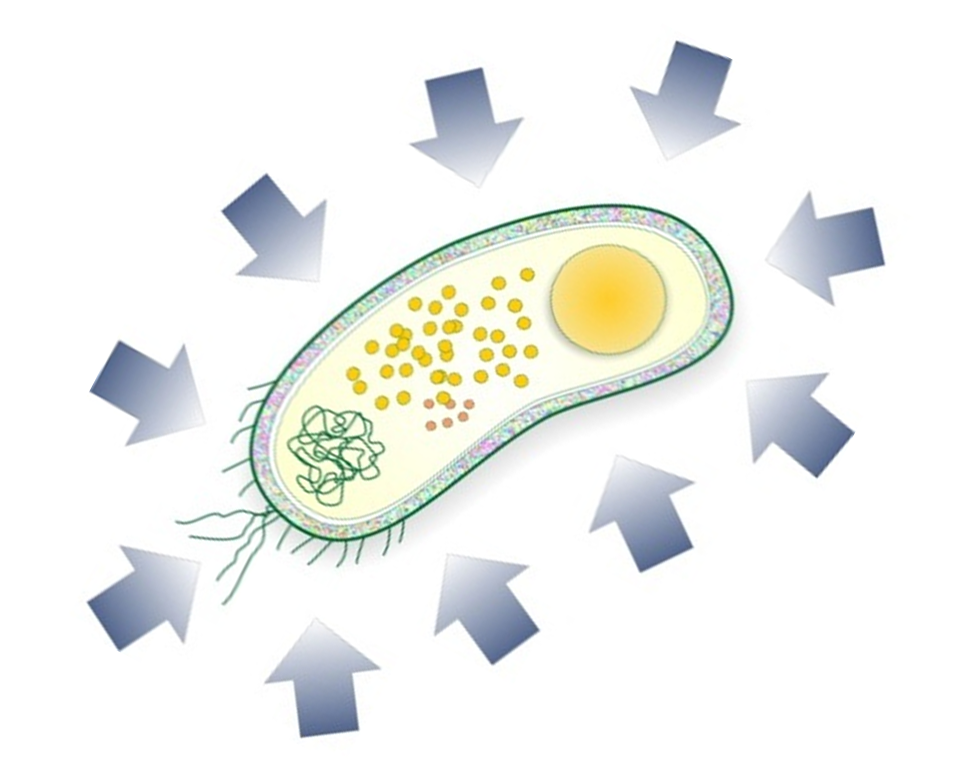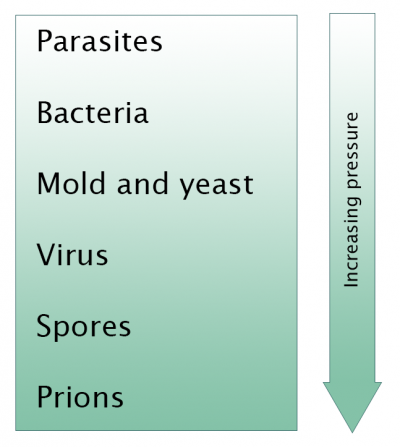
How different microorganisms are affected by high pressure
Different types of microorganisms are affected by pressure to varying degrees. A number of microbial properties are important, but the most important factor is undoubtedly what type of microorganism is involved. It is well known that the structure of a microorganism affects its ability to withstand pressure.
What happens in a microorganism as a result of pressure processing?
How affected a microorganism becomes as a result of exposure to high pressure depends greatly on the amount of pressure applied, processing time, temperature during processing and the medium in which the microorganism exists.
Inactivation of a number of microorganisms as a result of high pressure processing is a combination of various factors. The greatest changes and damage occur in cell membranes. Furthermore, changes occur in cell permeability and transport systems, loss of osmotic state, organelle disturbances and inability to preserve pH inside the cells.
Bacteria
The high pressure kills microbes by causing damage in the cells. How well the bacteria tolerate HPP varies, both between different species of bacteria and between different strains. In general, Gram-positive bacteria and bacteria in a stationary growth phase have higher resistance to high pressure than Gram-negative bacteria and bacteria that are in an exponential growth phase.
HPP is used to inactivate both spoilage bacteria and pathogenic bacteria, such as Listeria monocytogenes, Escheichia coli, Salmonella, Vibrio and a number of other bacteria. The amount of pressure used determines whether the bacteria are only damaged or killed. If they are only damaged, they can recover after a while and start to grow in a food product during storage. The extent and speed at which this occurs depend on the type of food or growth medium they are in, storage temperature and type of bacteria, etc.
The exact mechanisms behind inactivation of bacteria and other microorganisms under high pressure are not known in detail. High pressure does not affect any specific mechanism, but has an impact on a number of mechanisms such as inactivation of enzymes, cell membrane destruction and changes in cell structures. In general, bacteria exposed to a pressure above 400 MPa will have both reversible and irreversible changes in their cell membrane.
Some bacteria are barotolerant. To compensate for pressure differences on the inside and outside of the cell membrane, these bacteria make changes to the phospholipids in the cell membrane.
Spore-forming bacteria
Inactivating spores is a challenge in all types of processing. Spores tolerate much more than bacteria and are known to be highly pressure-resistant. In order to kill spores, HPP usually needs to be combined with heat, or two-step high pressure processing must be used.
Spores from several species of Clostridium and Bacillus have been shown to have very high tolerance to pressure above 1000 MPa at room temperature. The combination of high pressure and heat can have a beneficial effect on the killing of spores. In general, high pressure combined with heat, often above 50oC, inactivates both Bacillus and Clostridium spores in both growth mediums and food. A number of combinations involving HPP, antimicrobial substances and low pH have been tested. Some have been shown to increase the inactivation of spores, while others have little or no effect. The medium and the food which contain the spores may also have a considerable impact on their inactivation.
To inactivate spores, it appears that high pressure combined with heat is required. Although heat must then be used, the high pressure process may nevertheless still be a good alternative to conventional heat sterilisation or the use of autoclaves. The reason is that this process is very effective and has less effect on flavour, texture and nutritional value relative to conventional heat treatment.

Yiest and mould
Yeast and mould are generally more sensitive to high pressure than bacteria. The inactivation mechanisms of yeast are almost the same as for bacteria in that the cell membrane and cellular structures are affected and that changes occur in the proteins.
Some moulds may form ascospores and several of these may be pressure-resistant. These can be inactivated by, for example, a combination of high pressure and heat.
Viruses
Different viruses have different abilities to withstand high pressure. Viruses are often divided into two groups; those with a capsid (protein shell) and those without. The mechanisms are not known, but it is assumed that the reason why viruses are inactivated by high pressure is because the capsid proteins are destroyed.
The type of food containing the virus, either inside or outside, also affects whether it will survive HPP. Food components such as fats, proteins, carbohydrates and temperature can have a protective effect on viruses.
Parasites
There is little evidence to show how high pressure affects parasites. The few studies that have been carried out have focused on protozoa parasites and nematodes. Oocysts are the resistant forms of the protozoa parasites. Oocysts from parasites such as Cryptosporidium parvum, which are waterborne and can be found in shellfish, and Toxoplasma gondii, can easily be inactivated by the pressures used for food products today, between 340-550 MPa, with a relatively short holding time (3 min. or less).
Studies conducted on herring worms (the Anisakis simplex nematode) have shown that relatively low pressures (approx. 200-400 MPa) applied over a relatively short period of time (less than 3 min.) are enough to inactivate these parasites.
Some scientific articles:
Georget et al. (2015) Inactivation of microorganisms by high isostatic pressure processing in complex matrices: A review.
Podolak et al. (2020) Factors Affecting Microbial Inactivation during High Pressure Processing in Juices and Beverages: A Review.
Woldemariam and Emire (2019) High Pressure Processing of Foods for Microbial and Mycotoxins Control: current trends and future prospects.
Sehrawat et al. (2021) Microbial inactivation by high pressure processing: principle, mechanism and factors responsible.
Huang et al. (2014) Responses of microorganisms to high hydrostatic pressure processing.
Yamamoto et al. (2021) Bacterial Injury Induced by High Hydrostatic Pressure.
Evelyn and Silva (2019) Heat assisted HPP for the inactivation of bacteria, moulds and yeasts spores in foods: Log reductions and mathematical models.
